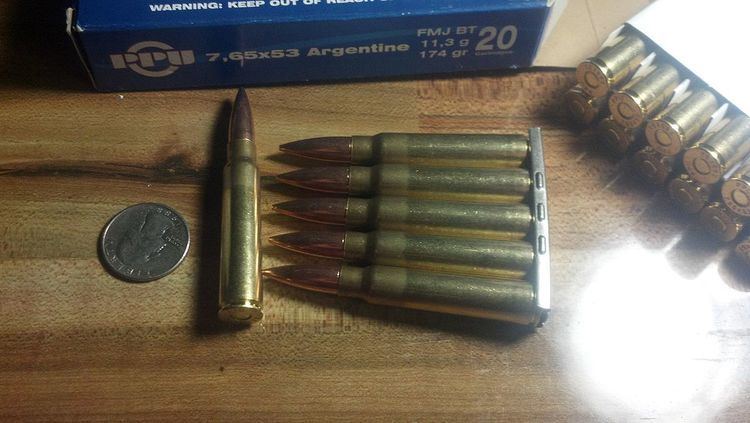Type Rifle In service 1889-1970s Designer Mauser | Place of origin German Empire Used by See Usage | |
 | ||
Wars World War I
Chaco War
Ecuadorian–Peruvian War
World War II | ||
The 7.65×53mm Argentine (designated as the 7,65 × 53 Arg. by the C.I.P.) is a rimless bottlenecked rifle cartridge developed for use in the Mauser Model 1889 rifle by Paul Mauser of the Mauser company. It is also known as 7.65×54mm Argentine rimless, 7.65mm Argentine, 7.65×53mm Belgian Mauser or 7.65mm Belgian (in the United States) and 7.65×53mm Mauser (in Belgium).
Contents
The 7.65×53mmR is a rimmed variant of the 7.65×53mm Argentine cartridge. Ballistically it is comparable to the also-rimmed .303 British cartridge.
Military use
At one time, the 7.65×53mm Argentine cartridge saw widespread military use. It was used by:
Chambered weapons
Some of the rifles it was used in were the Modelo 1891, Argentine Modelo 1909 Carbine, Modelo 1908, Modelo 1910, the Fittipaldi machine gun and the Argentine FN Model 1949. In Argentinian military service, the cartridge was used from 1891 to the early 1970s in Mauser bolt-action military rifles, as well as a semi-automatic rifle, the FN-49, manufactured by Fabrique Nationale in Belgium.
This cartridge was loaded commercially by many manufacturers in the United States until about 1936. Hornady is the only major U.S. ammunition manufacturer to still produce this cartridge. Sporting ammunition in this caliber is still loaded in Europe. Norma, Prvi Partizan, Sako and Fabricaciones Militares (FM) currently produce 7.65×53mm ammunition. For reloading the cartridge, use .303" British load data.
Cartridge dimensions
The 7.65×53mm Argentine has 3.70 ml (57.1 grains H2O) cartridge case capacity. The exterior shape of the case was designed to promote reliable case feeding and extraction in bolt action rifles and machine guns alike, under extreme conditions.
7.65×53mm Argentine maximum C.I.P. cartridge dimensions. All sizes in millimeters (mm).
Americans would define the shoulder angle at alpha/2 ≈ 22.2 degrees. The common rifling twist rate for this cartridge is 280 mm (1 in 11.02 in), 4 grooves, Ø lands = 7.65 mm, Ø grooves = 7.92 mm, land width = 4.20 mm and the primer type is large rifle.
According to the official Commission Internationale Permanente pour l'Epreuve des Armes à Feu Portatives (CIP) rulings the 7.65×53mm Argentine can handle up to 390.00 MPa (56,565 psi) Pmax piezo pressure. In CIP member countries every rifle cartridge combination has to be proofed at 125% of this maximum pressure to certify fit for sale to consumers. This means that 7.65×53mm Argentine chambered arms in CIP regulated countries are currently (2013) proof tested at 487.50 MPa (70,706 psi) PE piezo pressure.
The American .308 Winchester cartridge is a close ballistic twin of the 7.65×53mm Argentine. The .308 Winchester being a post World War II cartridge developed by Winchester to provide similar performance in a short bolt action format.
Due to the cartridge case's dimensions, production of 7.65mm brass can be accomplished by reforming 30-06 cases. Simply resize and trim.
Military ammunition
The original 1898 pattern military ball ammunition was loaded with a 13.65 grams (210.7 gr) round-nosed bullet fired at a muzzle velocity of 650 m/s (2,133 ft/s) with 2,884 J (2,127 ft·lbf) muzzle energy.
Following the lead of French and German army commands in developing the spitzer - a pointed-tip - bullet shape, later military ball ammunition was loaded with a 10 g (150 gr) spitzer bullet fired at a muzzle velocity of 830 m/s (2,723 ft/s) with 3,445 J (2,541 ft·lbf) muzzle energy from a 589 mm (23.2 in) long barrel became available. It had a maximum range of 3,700 m (4,046 yd).
After that military ball ammunition loaded with a 11.25 g (173.6 gr) spitzer bullet fired at a muzzle velocity of 725 m/s (2,379 ft/s) with 2,957 J (2,181 ft·lbf) muzzle energy from a 589 mm (23.2 in) long barrel became available. Besides a pointed nose this projectile also had a boat tail to further reduce drag. It had a maximum range of 5,000 m (5,468 yd).
